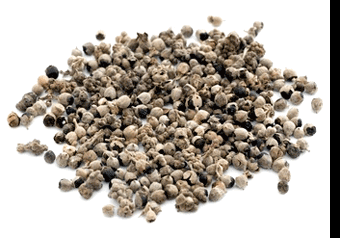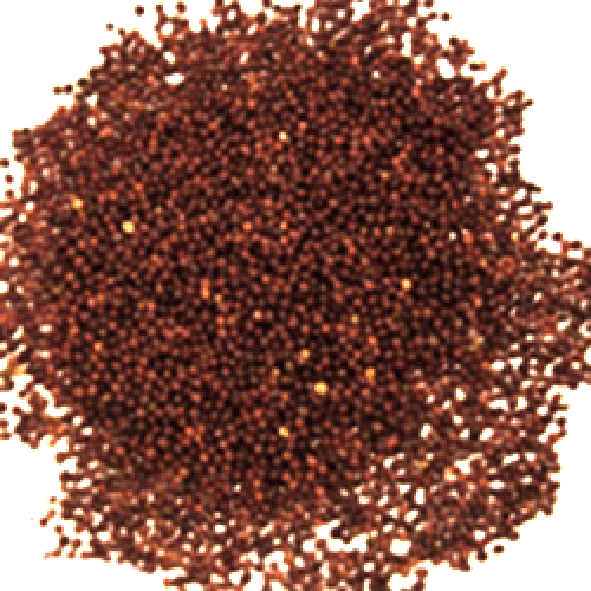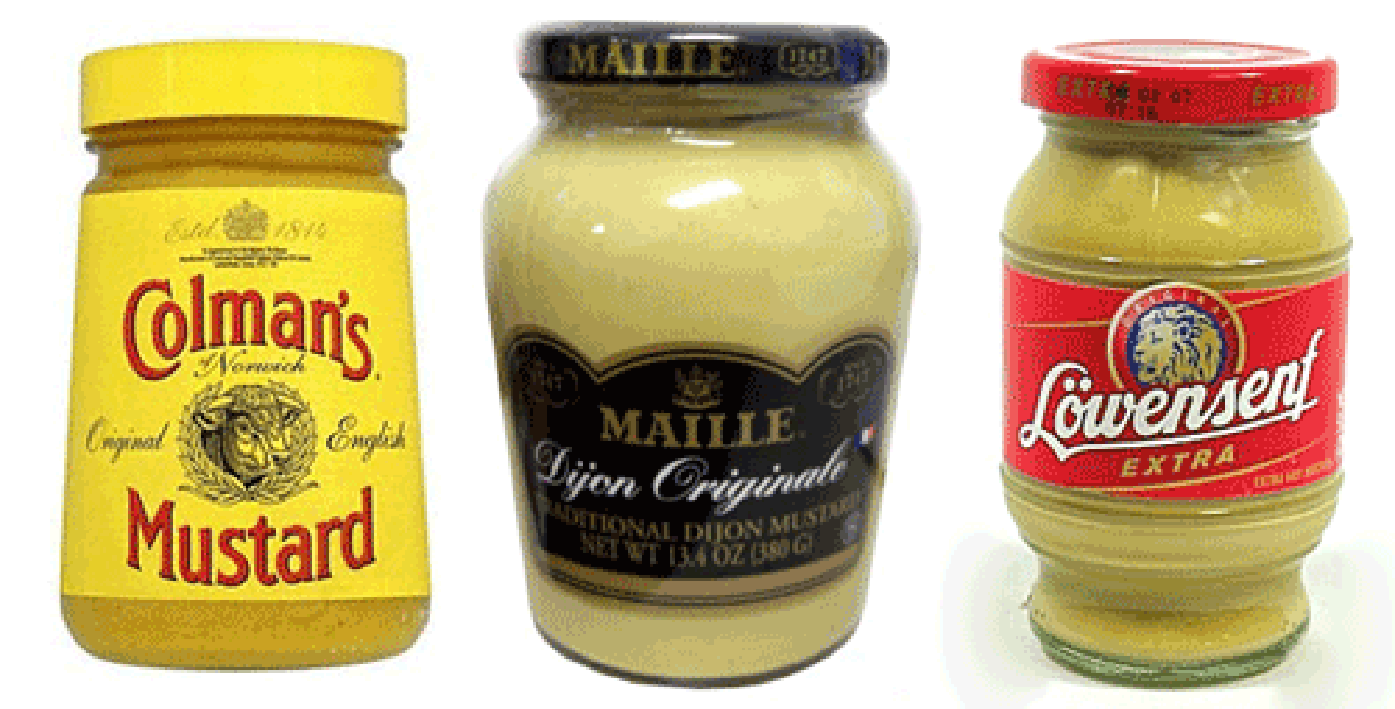FabulousFusionFood's Spice Guide for Mustard Seeds Home Page
 .
.
Welcome to the summary page for FabulousFusionFood's Spice guide to Mustard Seeds along with all the Mustard Seeds containing recipes presented on this site, with 642 recipes in total.
This is a continuation of an entire series of pages that will, I hope, allow my visitors to better navigate this site. As well as displaying recipes by name, country and region of origin I am now planning a whole series of pages where recipes can be located by meal type and main ingredient. This page gives a listing of all the Cornish recipes added to this site.
These recipes, all contain as a major flavouring.
Mustard seeds are the seeds of several plant species (all related to rapeseed) that produce seeds which are used as a spice. They are members of the Brassica family that includes broccoli, cauliflower, cabbage, kale and swedes. The green parts of many mustard plants are eaten as 'mustard greens'.
The word 'mustard' derives from the Latin (vinum) mustum (must or young wine). It was the Romans who popularized mustard in Central and Western Europe and made their condiments by mixing ground mustard with young wine (where vinegar is used today).
The pungency of all mustards is produced primarily from Sinalbin, a thioglycoside-like compound of glucose and p-hydroxybenzyl isothiocyanate (HO–C6H4–CH2–NCS). On cell damage (such as by crushing or grinding) the enzyme myrosinase hydrolyzes the sinalbin and produces free p-hydroxybenzyl isothiocyanate, a pungent and non-volatile substance.
The three culinarily most important mustard types are described below:
This is a continuation of an entire series of pages that will, I hope, allow my visitors to better navigate this site. As well as displaying recipes by name, country and region of origin I am now planning a whole series of pages where recipes can be located by meal type and main ingredient. This page gives a listing of all the Cornish recipes added to this site.
These recipes, all contain as a major flavouring.
Mustard seeds are the seeds of several plant species (all related to rapeseed) that produce seeds which are used as a spice. They are members of the Brassica family that includes broccoli, cauliflower, cabbage, kale and swedes. The green parts of many mustard plants are eaten as 'mustard greens'.
The word 'mustard' derives from the Latin (vinum) mustum (must or young wine). It was the Romans who popularized mustard in Central and Western Europe and made their condiments by mixing ground mustard with young wine (where vinegar is used today).
The pungency of all mustards is produced primarily from Sinalbin, a thioglycoside-like compound of glucose and p-hydroxybenzyl isothiocyanate (HO–C6H4–CH2–NCS). On cell damage (such as by crushing or grinding) the enzyme myrosinase hydrolyzes the sinalbin and produces free p-hydroxybenzyl isothiocyanate, a pungent and non-volatile substance.
The three culinarily most important mustard types are described below:
 White Mustard, Sinapis alba, (also known as Yellow Mustard, Brassica alba or Brassica hirta is an annual plant in the Brassicaceae (cabbage) family of flowering plants. White mustard is grown for its seeds (the spice), but it is also a fodder crop and a green manure. When fertilized, the yellow flowers of the plant yield hairy seed pods that typically contain about 6 seeds. For the spice, these are harvested and dried just before the pod ripens and naturally bursts. White mustard seeds are typically pale (ranging from tan to yellow to light brown) and are about 1.5mm in diameter. The dried seeds themselves do not have any taste, but exhibit a considerable pungency when crushed or ground and mixed with water (such as on chewing). The main flavour compound in white mustard seeds is sinalbin (see above). White mustard does not contain the flavour compounds of brown or black mustard (see below) and is therefore considered milder. However, white mustard is most commonly used for mustard pastes, for which they are considered superior, as their pungent compound (p-hydroxybenzyl isothiocyanate) is non-volatile and stable to hydrolysis in acidic environment (as in prepared mustards). White Mustard grows wild in North Africa, the Middle East and Mediterranean Europe and has spread farther by long cultivation (in Northern Europe early wild forms of Brassica rapa were probably used for their seeds which had a more mustard-like taste and less oil than modern cultivars as evidenced by the presence of their seeds in many neolithic burials). |
 Brown or Indian mustard (Brassica juncea), originally from the foothills of the Himalaya, is grown commercially in the UK, Canada and the US. This is an essential ingredient in many Indian recipes and has a higher level of volatile mustard oils that white mustard (and is thus stronger in taste and pungency, but not as strong as black mustard). The seeds are a ruddy brown in colour and tend to be slightly lighter in tone than the seeds of the Black Mustard, Brassica nigra. Brassica juncea is actually a fertile hybrid from Brassica nigra and Brassica campestris. It is mainly grown for its leaves and stems, though the seeds are also collected and are commonly used in Indian cookery. Since the 1950s this form of mustard has become more important as a spice, as some cultivars of Brassica juncea have seeds that can be harvested mechanically. This makes brown mustard the most commonly grown in Europe these days. |
 Black mustard (Brassica nigra) is grown in Argentina, Chile, the US and some European countries. This has the highest concentration of volatile mustard oil of all the mustard seeds and is by far the most pungent variety. It should be noted that black mustard seeds aren't called that because the seeds themselves are black (indeed they tend to be more russet in colour) but rather because they are the seeds of the 'Black Mustard' plant, Brassica nigra. Originally native to the Mediterranean region of Europe, black mustard plants have been extensively cultivated for their pungent seeds for thousands of years. The plant itself is a rather weedy annual and a member of the Brassicaceae (cabbage) family. The seeds are small compared with white and brown mustards (about 1mm in diameter) and vary in colour from dark brown to black. Black mustard is the commonest form or mustard used in mustard powders and prepared mustards (see below). It is also a very common ingredient in Indian cuisine, particularly curries where the seeds are fried in oil before use. |
 Mustard seeds can be fried in oil until the seeds 'pop', yielding a flavoured oil, as is done in Indian cuisine. The seeds can also be ground and added to stews and meat dishes. In the west, the most common use of mustard seed is in the form of a prepared mustard condiment. This is made by mixing mustard powder with a liquid such as water, wine, honey or even milk to form the paste. The 'heat' of such mustards being reduced by mixing the ground mustard with flour. This kind of condiment was probably first prepared by the Romans who mixed ground mustard with unfermented grape juice to produce mustum ardens (burning must). As one of the few hot spices native to Europe mustards were very commonly used during the Medieval and Elizabethan periods, as exemplified by this recipe for Collar of Brawn and Mustard. Of the various commercial mustards, English mustard (image, left) powder is the hottest. This is a blend of finely ground black with a little ground white mustard, finely-ground wheat flour (which acts to make it smooth when mixed with water) and turmeric to yield its yellow colour. It comes either pre-blended or in the form of a powder to be mixed at home (or to be added to other dishes as a spice). This makes English mustard very pungent (indeed, it is one of the most pungent spices available today). Dijon mustard (image, centre) is slightly milder, but it is still made from hulled black mustard seeds mixed with white wine vinegar or verjuice and turmeric (to yield its yellow colour). The other main type of French mustard is Bordeaux mustard which is much miler and made with white mustard seeds (that have their seeds coat removed), vinegar, spices, sugar and a range of herbs. In Germany, there are two main types of traditional mustards. Düsseldorf mustard (image, right) is similar to Dijon mustard and is made from black mustard seeds. Bavarian style is milder and is made from coarsely-ground white mustard seeds mixed with honey and herbs. Typically this mustard is used with sausages. American mustards are much blander and tend to be made from ground white mustard seeds mixed to a paste with vinegar, sugar and turmeric. |
The alphabetical list of all Mustard Seeds recipes on this site follows, (limited to 100 recipes per page). There are 642 recipes in total:
Page 1 of 7
| A Messe of Greens Origin: Britain | Anglo-Indian Ball Curry Origin: Anglo-Indian | Bermuda Rockfish Coconut Curry Origin: Bermuda |
| Achaari Jhinga (Indian Pickled Prawns) Origin: India | Anglo-Indian Mutton Dakbungalow Origin: Anglo-Indian | Bermudan Potato Salad Origin: Bermuda |
| Achari Masala Origin: India | Antiguan Curry Powder Origin: Antigua | Bermudan Spinach Salad Origin: Bermuda |
| Adenydd Cath Fôr gyda Saws Tartar Cyflym (Fried Skate Wings with Quick Home-made Tartar Sauce) Origin: Welsh | Appetizer Pate Cheesecake Origin: American | Best Ever Barbecued Burgers Origin: British |
| African Fish Curry Powder Origin: West Africa | Artichauts camus sauce bretonne (Camus artichokes with Breton sauce) Origin: France | Bhojpur Mutton Curry Origin: India |
| Air Fryer Honey-glazed Ham Origin: Britain | Aruba Curry Powder Origin: Aruba | Bihari Lamb Curry Origin: India |
| Alas a la Mostaza (Chicken Wings with Mustard) Origin: Spain | Ash Gourd Coconut Curry Origin: India | Black Curry Powder Origin: Sri Lanka |
| Alas con mostaza (Mustard Chicken Wings) Origin: Mexico | Asparagus with Scrambled Eggs Origin: British | Black Mustard Flowers, Mushroom and Seaweed Soup Origin: Britain |
| Alexanders Chutney Origin: Britain | Assam Fish Curry Origin: Malaysia | Black Mustard Leaves, Tricorn Leek and Millet Origin: Fusion |
| Aliter Betas Elixas (Another: Stewed Beets) Origin: Roman | Atchar Origin: Southern Africa | Bo-Kaap Kerrie (Cape Malay Curry) Origin: South Africa |
| Aliter Fabaciae (Green Beans, Another Way) Origin: Roman | Aukstá Zupa (Latvian Pink Soup) Origin: Latvia | Bo-Kaap Kerrie Poeier (Cape Malay Curry Powder) Origin: South Africa |
| Aliter in Apro (Wild Boar, Another Way) Origin: Roman | Badanekaayi Gojju (Brinjal Curry) Origin: India | Boiled Collar of Bacon with Creamy Mustard Sauce Origin: Ireland |
| Aliter in Elixis Palumbis sive Columbis (Sauce for Boiled Wood Pigeons and Doves) Origin: Roman | Bajan Macaroni Pie Origin: Barbados | Bolitas de Jamon (Ham Balls) Origin: Aruba |
| Aliter in Grue vel Qnate Elixa (Sauce for Boiled Crane or Duck, Another Way II) Origin: Roman | Balti Tandoori Keema Origin: Britain | Bombay Aloo (Bombay Potatoes) Origin: Britain |
| Aliter in Gruem vel Anatem Elixam (Sauce for Boiled Crane or Duck, Another Way) Origin: Roman | Bangladeshi Vindaloo Origin: Britain | Bombay Egg and Potato Curry Origin: Anglo-Indian |
| Aliter in Palumbis sive Columbis (Sauce for Boiled Wood Pigeons and Doves, Another Way) Origin: Roman | Barbecue Sauce Origin: American | Bombay Potatoes Origin: India |
| Aliter In Struthione Elixo (Of Boiled Ostrich, Another Way) Origin: Roman | Barbecue Steaks with Red Onion Marmalade Origin: Britain | Bonnie Prince Pudding Origin: Scotland |
| Aliter in Vitulina Elixa (Sauce for Boiled Veal, Another Way) Origin: Roman | Barbecued Lamb Ribs Origin: Britain | Bottle Masala Origin: India |
| Aliter Ius Frigidum in Aprum Elixum (Cold Sauce for Boiled Wild Boar, Another Way) Origin: Roman | Barbecued Prawns and Scallops with Curry-apricot Sauce Origin: American | Brine-pickled Himalayan Balsam Pods Origin: American |
| Aliter Ius in Mugile Salso (Another Sauce for Salted Grey Mullet) Origin: Roman | Barbecued Spice-crusted Lamb Origin: Britain | Brine-pickled Radish Pods Origin: American |
| Aliter Ius in Murena Elixa (Another, Sauce for Poached Moray Eel) Origin: Roman | Bavarian Veal Origin: Germany | Brinjal and Dryfish Pahi Origin: Sri Lanka |
| Aliter Leporem Conditum (Another, Seasoned Hare) Origin: Roman | Beef in Bitter Origin: Britain | Brinjal Bharta Origin: Anglo-Indian |
| Alleppey Fish Curry Origin: India | Beef Madras Origin: India | Brochette de Poisson Tchadienne (Chadian Fish Kebabs) Origin: Chad |
| Aloo Bhaji Origin: India | Beef Wellington Origin: Britain | Brown Sauce Origin: Britain |
| Aloo Bharta (Indian Mashed Potatoes) Origin: Anglo-Indian | Beetroot and Celeriac with Pickled Blackberries Origin: Britain | Burdock Flower Stem Gobi Origin: Britain |
| Aloo Gobi Origin: Britain | Beetroot Relish Origin: Britain | Burdock Pickles Origin: Britain |
| Aloo Masala (Potato Masala) Origin: India | Beetroot Sabzi (Beetroot Curry) Origin: India | Buttered Alexanders Origin: Britain |
| Aloo Palya (Potato Curry) Origin: India | Beetroot, Orange and Pumpkin Sambal Origin: Lesotho | Butterflied Lamb Shoulder with Salsa Verde Origin: Britain |
| Alu Achari Origin: India | Beetroot-stuffed Parathas Origin: India | Bygan Dhal Origin: India |
| Alu Kesel (Sri Lankan Ash Plantain Curry) Origin: Sri Lanka | Bengali Fish and Potato Curry Origin: Bangladesh | Caesar Salad Origin: Mexico |
| Alu Tarkari (Potato Curry) Origin: Nepal | Bengali Fish Curry Origin: India | Cajun Blackening Spices Origin: Cajun |
| Amchar Masala Origin: Trinidad | Bengali Mustard Tlapia Origin: Bangladesh | Cajun Brew Pork'n'Beans Origin: American |
| Amchar Masala Origin: Trinidad | Bermuda Curry Powder Origin: Bermuda | |
| Andhra Pappu Charu (Andhra-style Lentil Puree Curry) Origin: India | Bermuda Onion and Potato Salad Origin: Bermuda |
Page 1 of 7